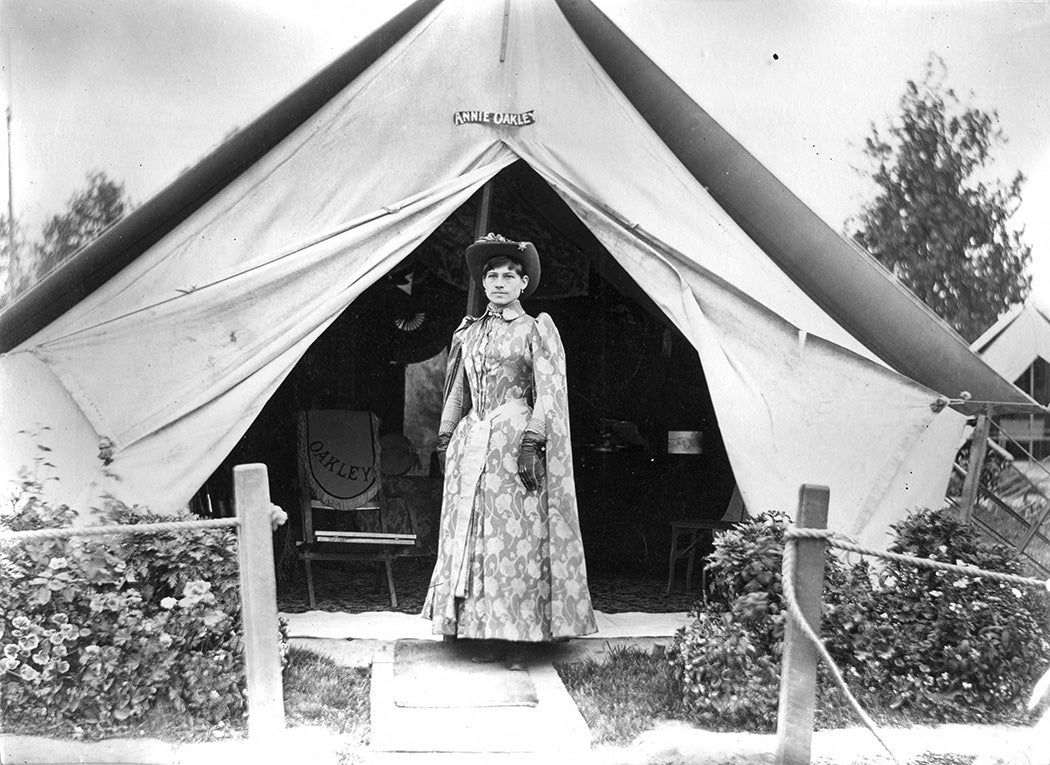In the 1894 Thomas Edison film short Annie Oakley, we see Annie, the famed sharpshooter, take out six targets in quick succession. Her male assistant (possibly her husband, Frank Butler) darts into the frame, and she switches guns and crouches down into a squat, pointing her barrel into the air. He tosses up new targets, and she hits those too, never breaking a sweat.
These were the kind of stunts that “Little Sure Shot” performed for audiences across the country in Buffalo Bill’s Wild West show. She was famous for her precision and athleticism, but she was known for something else too, something that’s very clear in the Edison movie: her femininity. With her full skirts, poise, and ever-present husband, Oakley never let you forget that she was a cowgirl, setting a foundational precedent for female gunslingers in pop culture that persisted long after her death.
Oakley was an excellent markswoman from an early age. Born Phoebe Ann Moses, she grew up in a large family where money was scarce. Her father died when she was still a child, leaving behind seven children and one struggling widow. To help the family survive, Oakley began shooting game to sell to a local Ohio shopkeeper. As she got older, she entered contests—most famously, one against Frank Butler, a traveling sharpshooter. The showdown is now the stuff of legend—Oakley’s de facto origin story. As such, it’s hard to pin down concrete details, but the important part is that Oakley won, and Butler was so impressed he married her.

The couple started a touring act, which eventually caught the eye of William “Buffalo Bill” Cody. Once they joined his show, Oakley shot her way to stardom, in no small part because of her carefully curated image. As Oakley biographer Glenda Riley argues in Montana, the Magazine of Western History, her distinctly Victorian sensibility “made Annie acceptable and appealing to everyone in her audience, young or old, male or female, old-fashioned or modern.”
This appeal was reflected in Oakley’s wardrobe (always long skirts, never trousers), as well as the way she rode her horse (sidesaddle, even when she was performing tricks). Oakley also maintained this demeanor outside the arena. “She furnished her tent/dressing room with a Brussels carpet, a rocking chair, and a parlor table,” Riley writes. “Between appearances, Annie sat in the chair, her guns lining the walls, and did fancy embroidery. After shows, Annie often entertained guests with punch, tea, cakes, and ices.”

This very deliberate performance, which also included a “dependence on men,” like Butler and her male assistants, “assured women that, although independent and perhaps employed, they could still be domestic.” It made Oakley more accessible to the masses—especially compared to her show rival, Lillian Smith. Smith, the so-called “California Girl,” was considered more flirtatious, more braggadocious, and more vulgar. She did not go down in history books, at least not to the same degree, for a simple reason: Oakley’s brand was more appealing.
It was such a powerful brand, in fact, that it seeped into another form of entertainment: film. In addition to the Edison short (watch it; it’s only 20 seconds long), fictionalized versions of Oakley later appeared in the 1935 biopic Annie Oakley and the 1950 musical Annie Get Your Gun, an adaptation of the 1946 Broadway show. Both films, Riley notes, rewrote a key piece of Oakley’s biography to make her even more demure and ladylike: she loses the shooting contest to her future husband.
Weekly Newsletter
These little concessions, designed to make the figure of the cowgirl less threatening, were not confined to movies about Oakley. In Calamity Jane (1953), the eponymous cowgirl pines over a man who loves her more conventionally feminine friend. Jane stuffs herself into a pink ballgown to win his affections, but she still loses. She only finds love with another man after he humiliates her with a gun trick—recalling the “lost” shootout of the Oakley films. (Calamity Jane appeared as a character even earlier, in 1948’s The Paleface, a movie that advertised the heroine in white, frilly bloomers to undercut the pistols in her hand.)
The image of the cowgirl has progressed since then, particularly on television, but in many ways, Oakley was the original encapsulation of the unwinnable question: can women have it all? As her own life demonstrates, you can beat men in shooting contests, achieve national fame, and inspire women the world over, but if you’re not sitting sidesaddle, you might lose the crowd.
Support JSTOR Daily! Join our new membership program on Patreon today.







